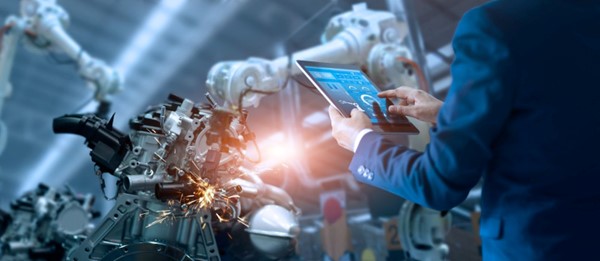The Rise of Automation in Metalworking: Exploring the Benefits of Precision Technology
In many respects, metalworking has been integral to the development of modern societies all over the world. The shaping of metal has been used throughout the ages to form religious artifacts, societal status symbols, fashion tools, and build structures. Metalworking involves mastering a number of techniques including welding, molding, and casting.

Metals, both ferrous and non-ferrous are a finite resource. And yet, they are just as vital to society as they have ever been, due to their use in everything from advanced robotics and vehicles, to electronic equipment and much of the power generation and water infrastructure. Automation in metalworking not only allows the efficient use of this vital material, but also facilitates the many technical processes that make metalworking as much an art as it is a science. In this article, we’ll explore the metalworking processes that require precision and the benefits that automating these processes bring to the table.
Metalworking Processes that Require Precision
When considering the precision processes vital to a successful metalworking project, it’s just as important to understand the medium (or material) you’re working with as it is to be skilled in your craft. Meaning that while many of the techniques used in metalworking are similar in application from one material to the next, having familiarity with the differing properties of each material is integral to achieving the desired outcome. Metalworkers, like other skilled professions are able to leverage their knowledge and experience to produce some truly remarkable and precise work. The following is a conservative list consisting of just a few of the precision tasks that make up metalworking.
Cutting - Much of what goes into shaping metal involves the removal of unneeded, excess material. Whether it’s through milling, routing, turning, or by using a CNC, shaping a piece of metal will invariably involve cutting a portion of it away. Of course, cutting through metals of varying densities and thicknesses can be a long and arduous process. Fortunately, this task is made easier through the use of advanced tools like plasma cutters. Plasma cutters are gas-powered torches that burn a mixture of hydrogen and argon (35% and 65%, respectively) and are capable of cutting metals like aluminum and stainless steel with a high degree of precision. This mixture of gasses, referred to as H-35, produces the highest burning plasma, and thus provides the best results in terms of cutting metal.
Joining - Similarly, much of shaping metal into a functional product requires the combination of two or more pieces to form a singular piece. Combined or joined metal should be strong and just as durable - if not more so - than its individual parts. Metals can be welded or soldered to one another. The former process, welding, leverages heat, pressure, or both to literally fuse two pieces of metal together. As the metal cools, a join forms and the two pieces become one. There are several types of welding, including TIG, MIG, laser, and thermit, among others. Typically, welding is the joining method of choice for large projects. Soldering, on the other hand, is most useful on small, mission critical projects such as the fabrication of aerospace and medical device components. This process bonds two pieces of metal together by carefully melting solder at the point of contact. The most common types of soldering include lead-based, lead-free and flux.
Forming - In the absence of cutting and joining, metalworkers can form pieces of metal into the desired shape depending on the desired outcome. As with the other processes described thus far, forming metal is generally achieved through the application of heat and pressure, though heat isn’t always necessary. For example, metals like aluminum and steel can be formed and shaped without using heat through a process known as cold forming.
Casting - Casting is a process that includes pouring molten metals into a preformed mold to produce all types of things including statues, jewelry, tools and more. Casting allows objects to be made at regular intervals and in similar quality. Die casting and sand casting are two of the most commonly used casting techniques.
Why Metalworking Operations are Leveraging Automation Technology
Now that we understand the basics of metalworking and the processes therein, we can begin delving into why an increasing number of metalworking operations are turning towards using automation technology. There are many reasons why metalworking operations would choose to automate some or all of their processes, not least of which is due to the sophisticated nature of the associated products. Below is a list of additional reasons why automating metalworking is beneficial. As an interesting side note, if you’ve spent some time learning about the many benefits of automation in an industrial setting, some of the information you’re about to read might sound familiar.
Reduction in manufacturing errors - Automation as a whole has long been associated with reducing the number of errors/faulty components that most often come at the hands of human workers. The bulk of human error can be tracked to monotonous and repetitive tasks that can cause the worker to have a momentary lapse in concentration. Conversely, automated systems can perform the same task a million times over without the threat of distraction or boredom. The point is, that while automation and robotics are not completely immune to the occasional error, technology greatly outperforms human workers by an ever increasing margin in all manner of physical processes. This is as true for metalworking as it is for just about any other industry that employs automation.
Greater control - Metalworking often requires highly precise cuts, joins, and weldments, something that calls for more than a steady hand. CNC mills and other tools can move and make adjustments in ways that humans simply cannot replicate. Additionally, some advanced automation equipment can complete metalworking tasks at a scale that is simply too difficult for the human eye to perceive. This kind of motor and process control means that intricate designs the likes of which were previously impossible can now be executed flawlessly and repeatedly by a system that never tires and never needs a break.
Repeatable results - From a business perspective, it is important that results are reliably consistent. A business that knows that x number of products are produced during the span of one operational day has a greater degree of control over cost and profits. While a skilled metalworker could very well produce exceptional quality day in and day out, there is far more variability when it comes to employing a human worker. There are many factors that could impede a metalworker from generating a reliable output, factors that simply don’t come into play with an automated system.
Transitioning to an Automated Metalworking Setup
It’s one thing to extoll the benefits of automation and leveraging technology in favor of staying the course with a predominantly human workforce, and quite another to execute the transition of operations.
In most cases, it is advisable this transition be done strategically and at a pace that will not disrupt operations. Many manufacturers - metalworking operations among them - simply can’t afford the financial cost of shifting all operations to automated systems in one fell swoop. While the cost of robotics and automation systems are lowering over time, it is still very much recommended that a methodical transition be taken to avoid any unnecessary financial burden. Consider evaluating each process and estimate the ROI and improved efficiency that automation will yield should that process be replaced. Once completed, a transition strategy can be developed that will see a gradual move to a desired level of automation.
Next, be mindful that automation will not herald the end of human metalworkers. Automation technology is generally collaborative in nature and thus requires some human involvement. Metalworking operations will still largely benefit from maintaining a human workforce, as trained metalworkers with ample knowledge and experience will prove invaluable for troubleshooting, inspecting raw materials, and determining new efficiencies. Human workers will also be needed to maintain the automation equipment and ensure it is calibrated correctly. Diligently adhering to inspection and maintenance schedules ensures that the automation technology is leveraged to its full potential and operates as intended.
Metalworking Without Automation is a Thing of the Past
Metals and metalworking are crucial to the advancement of society. From an execution perspective, metalworking at the hands of the human worker can never be done as cheaply or as efficiently as the same processes completed by a sophisticated automation system. With that said, human workers are by no means collateral damage in the face of automated metalworking systems; workers with the right skillset are still very much necessary to ensure the equipment is operating optimally and within specifications. In fact, automation technicians do more than maintain automation systems, they’re also integral to their design and installation. If you would like to learn more about automation technology applications and how you may contribute to an automated metalworking operation, contact George Brown College today by calling 1-888-553-5333 and speaking to a Program Consultant.

Very informative!